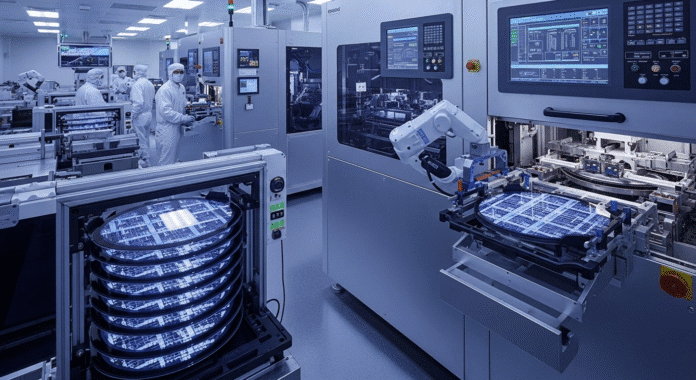Micron’s $100K Promise: Tech Giant Steps Up for Clay Community
Major Semiconductor Company Offers Reimbursement for Chip Factory-Related Expenses
Micron Technology has made a significant commitment to the town of Clay, proposing to reimburse local expenses related to its massive new semiconductor manufacturing facility. The tech giant’s offer includes establishing a$100,000 retainer account specifically designated for fees and costs associated with the chip factory project, demonstrating corporate responsibility and community partnership in what represents one of Central New York’s most substantial economic development initiatives.
This financial commitment reflects Micron’s recognition that large-scale industrial projects create substantial administrative and infrastructure demands on local communities. By proactively addressing these concerns, the semiconductor manufacturer is setting a positive precedent for how major corporations can support the municipalities that welcome their operations.
The Micron Clay Chip Factory Project
Scale and Significance
Micron Technology’s chip manufacturing facility in Clay represents a transformative investment for Central New York. The semiconductor industry has become increasingly critical to national security and economic competitiveness, making projects like this essential for American technological independence. The Clay facility will produce memory chips crucial for everything from smartphones and computers to automotive systems and data centers.
The project brings high-tech manufacturing jobs to an area that has historically relied on traditional industries. These positions typically offer excellent wages and benefits while providing opportunities for local residents to develop skills in cutting-edge technology sectors.
Community Impact and Challenges
While the economic benefits of the Micron facility are substantial, large industrial projects inevitably create challenges for host communities. Local governments must invest in infrastructure improvements, additional services, and administrative capacity to support major developments. These upfront costs can strain municipal budgets, particularly in smaller communities like Clay.
The$100,000 retainer account proposed by Micron acknowledges these realities and provides Clay with dedicated resources to address project-related expenses. This proactive approach helps ensure that the benefits of economic development are not overshadowed by financial burdens on local taxpayers.
Corporate Responsibility in Economic Development
Setting New Standards
Micron’s commitment to reimbursing Clay for factory-related expenses represents a thoughtful approach to corporate citizenship. Rather than simply expecting communities to absorb the costs associated with hosting major industrial projects, the company is taking responsibility for its impact on local resources and services.
This model of corporate engagement could influence how other companies approach community relations in future development projects. When corporations actively support the communities where they operate, it creates stronger partnerships and more sustainable economic growth.
Financial Mechanics of the Proposal
The$100,000 retainer account provides Clay with immediate access to funds for expenses directly related to the chip factory project. This arrangement allows the town to address costs as they arise without waiting for lengthy reimbursement processes or straining existing budgets.
The retainer structure demonstrates Micron’s confidence in its partnership with Clay while providing the municipality with financial flexibility during the project’s development phases. This approach helps ensure that both parties can focus on successful project implementation rather than financial negotiations.
Economic Development Benefits
Job Creation and Workforce Development
The Micron facility represents a significant opportunity for Central New York’s workforce. Semiconductor manufacturing requires skilled technicians, engineers, and support personnel, creating career paths that didn’t previously exist in the region. These positions typically offer competitive salaries and opportunities for advancement in a growing industry.
Local educational institutions are already developing programs to prepare workers for careers in semiconductor manufacturing. The partnership between Micron, area colleges, and workforce development organizations creates a comprehensive approach to building the skilled labor force needed for long-term success.
Supply Chain and Secondary Benefits
Large manufacturing facilities like Micron’s chip factory create ripple effects throughout the local economy. Suppliers, service providers, and support businesses all benefit from the increased economic activity. Restaurants, retail establishments, and housing markets typically see positive impacts when major employers establish operations in their communities.
The semiconductor industry also tends to attract related businesses and research activities, potentially creating a technology corridor that brings additional investment to Central New York. This clustering effect can transform regional economic prospects over time.
Infrastructure and Planning Considerations
Municipal Services and Capacity
The arrival of a major industrial facility requires communities to evaluate their capacity to provide essential services. Water, sewer, transportation, and emergency services must all be adequate to support both the facility and its workforce. Clay’s partnership with Micron helps ensure that infrastructure needs are addressed proactively.
The reimbursement arrangement provides Clay with resources to conduct necessary studies, hire consultants, and implement improvements that benefit both the chip factory and the broader community. This collaborative approach to infrastructure development creates better outcomes for all stakeholders.
Long-term Community Planning
Successful integration of major industrial projects requires comprehensive planning that considers both immediate needs and long-term community development goals. The financial resources provided by Micron enable Clay to engage in thorough planning processes that protect community interests while supporting economic growth.
This planning includes considerations for residential development, transportation networks, environmental protection, and quality of life improvements that make communities attractive to the skilled workforce that high-tech industries require.
National Context and Strategic Importance
Semiconductor Industry and National Security
The Micron facility in Clay contributes to broader national goals for semiconductor manufacturing capacity. Recent global supply chain disruptions highlighted America’s dependence on overseas chip production, making domestic manufacturing facilities like this one strategically important for economic security.
Federal initiatives to support domestic semiconductor production recognize the critical nature of these industries. The Clay facility positions Central New York as part of America’s technology manufacturing base, bringing both economic opportunities and strategic value to the region.
Competition and Innovation
The semiconductor industry remains highly competitive globally, with companies like Micron competing against international manufacturers who often receive significant government support. Successful domestic facilities require not only corporate investment but also supportive communities and efficient regulatory processes.
Micron’s commitment to working collaboratively with Clay demonstrates the kind of public-private partnership that makes American manufacturing competitive in global markets. This cooperation benefits both the company and the community while advancing broader economic interests.
Building Sustainable Partnerships
The Micron-Clay partnership represents more than just a business transaction; it’s a model for how corporations and communities can work together for mutual benefit. By addressing the financial impacts of major development projects proactively, companies like Micron help ensure that economic development creates winners rather than imposing costs on local taxpayers.
This approach to corporate responsibility builds trust and long-term relationships that benefit all stakeholders. As the chip factory project moves forward, the strong foundation established through financial cooperation and mutual respect will support ongoing collaboration and shared success.
The success of this partnership could influence how other major employers approach community relations, creating a positive cycle where economic development strengthens rather than strains local communities. For Central New York, this represents an opportunity to attract additional investment while maintaining the quality of life that makes the region attractive to residents and businesses alike.



